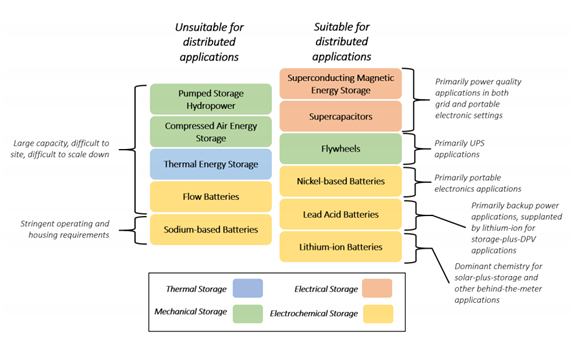Technology basics
Skip to:
Background
Storage Technology Types and Applications by Storage Medium

Source: NREL 2020
Technical Characteristics of Energy Storage
Each technology, whether large utility-scale systems like pumped storage hydropower or small behind-the-meter systems like lithium-ion batteries, will have set characteristics and unique advantages and disadvantages that affect the degree to which they are suitable for different applications. The definitions of several of these characteristics are provided below. While some of these characteristics may be unique to a specific technology, many of them broadly apply to all energy storage technologies.
Definitions of Key Energy Storage Technical Characteristics
|
Technical Characteristic |
Definition |
|
Rated power capacity |
Total possible instantaneous discharge capability (in kilowatts [kW] or megawatts [MW]) of the battery energy storage system (BESS), or the maximum rate of discharge that the BESS can achieve, starting from a fully charged state |
|
Energy capacity |
Maximum amount of stored energy (in kilowatt-hours [kWh] or megawatt-hours [MWh]) a battery can hold |
|
Energy/power density |
Measure of the energy or power capacity of a battery relative to its volume (kW/L, kWh/L) |
|
Specific energy/power |
Measure of the energy or power capacity of a battery relative to its weight (kW/g, kWh/g) |
|
Storage duration |
Amount of time storage can discharge at its power capacity before depleting its energy capacity |
|
Cycle life/lifetime |
Amount of time or number of cycles a battery storage system can provide regular charging and discharging before failure or significant degradation |
|
Round-trip efficiency |
Ratio of the energy charged to the battery to the energy discharged from the battery |
|
Self-discharge |
Reduction of stored energy of the battery (percentage of charge/time) through internal chemical reactions, rather than through discharging to perform work |
|
Dispatch |
The way that the battery is operated, including the times at which it is charged and discharged, and the depth of charge or discharge |
|
Degradation |
The decrease in the battery’s capacity over time and through use |
|
State of charge |
The battery capacity as a percentage of its maximum capacity at a given time |
|
Depth of charge |
The battery capacity that has been discharged as a percentage of its maximum capacity |
Reading List and Case Studies
USAID Energy Storage Decision Guide for Policymakers
National Renewable Energy Laboratory, 2021
As many countries seek to reduce their carbon emissions and increase the amount of VRE on their grids, storage provides an attractive solution to provide grid flexibility and reliability. This report is designed to arm relevant decision makers with the initial layer of information they need to understand energy storage and to make informed policy, regulatory, and investment decisions around grid-connected energy storage. While many of the case studies presented in this report are based on experiences from the U.S. and Europe, the lessons learned can be applied to power sectors in emerging economies. The report is focused on grid-connected storage, meaning storage that is connected to a centralized power system. The USAID Grid-Scale Energy Storage Technologies Primer is a useful companion resource to this report.
USAID Grid-Scale Energy Storage Technology Primer
National Renewable Energy Laboratory, 2021
Higher penetrations of VRE can drive additional need for power system flexibility. Energy storage is one method of power system flexibility that has gained attention in recent years. This primer is intended to provide regulators and policymakers with an overview of current and emerging energy storage technologies for grid-scale electricity sector applications. This work provides an overview and compares key operating characteristics of select energy storage technologies and explores how these storage technologies may be used to improve the flexibility and reliability of power systems given their technical characteristics. The report covers various electrochemical (lithium-ion, lead-acid, flow, sodium-sulfur), chemical (hydrogen), mechanical (pumped hydro storage, compressed air energy storage, flywheels, gravity) and electrical (supercapacitors) storage mediums. The USAID Energy Storage Decision Guide for Policymakers is a useful companion resource to this report.
National Renewable Energy Laboratory, 2021
This NREL page provides information on different storage technologies and applications. On this page you can find information on NREL storage research projects as well as recent publications.
Handbook on Battery Energy Storage System
Asian Development Bank, 2018
This handbook serves as a guide to deploying battery energy storage technologies, specifically for distributed energy resources and flexibility resources.
DOE/EPRI 2013 Electricity Storage in Collaboration with NRECA
Sandia National Laboratories, Electric Power Research Institute, National Rural Electric Cooperative Association, AECOM Technical Services, Inc, 2013
The Electricity Storage Handbook (Handbook) is a how-to guide for utility and rural cooperative engineers, planners, and decision makers to plan and implement energy storage projects. The Handbook also serves as an information resource for investors and venture capitalists and provides the latest developments in technologies and tools to guide their evaluations of energy storage opportunities.

